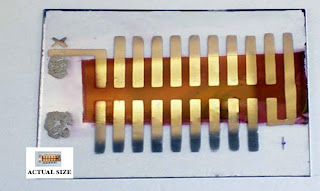Engineers have constructed a solar array smaller than a dime out of 20 solar cells, each cell tinier than a quarter of this lowercase "o."
The mini photoelectric device only generates seven volts of electricity. But that could be enough to power the kind of microsensors military planners imagine will provide the soldier of the future with first-person-shooter-like battlefield intelligence. That's why the Army is a major sponsor of the project, which is described in the Journal of Renewable and Sustainable Energy.
Unlike conventional silicon solar cells, the new device is created from carbon-based, organic polymers. The study's authors argue the array could transform electronics, even though right now it is far less efficient than silicon cells.
"The world’s next generation of microelectronics may be dominated by 'plastic electronics' and
organic solar cells are expected to play an important role in these future technologies," writes lead author, Xioamei Jiang.
The Army is leading the charge on microscale power production for one simple reason. Energy — in the form of batteries — is expensive and heavy on the battlefield, so the armed forces have been pouring money into alternative-energy projects that could provide long-lasting, self-produced and cheap electricity. One alt-energy startup founder noted earlier this year that soldiers can pack 30 pounds of batteries for a 24-hour mission. He estimates such a load of batteries, and the supply lines necessary to provide them, costs the military $57,000 per soldier per year.
Jiang began building the solar-power array in an effort to run a microscopic sensor known as a microelectromechanical system, which uses carbon nanotubes to sense dangerous chemicals. The array can't fully power the system yet, but they anticipate that a future generation of the array could charge the detector, perhaps by next year.
The Army's interest is broad. They are looking into a wide variety of low-power sensors that monitor the soldier's body and environment. When integrated with other technologies, the technology could eventually provide real-time data about the soldier's mind, body and military situation.
"You can start to imagine how power becomes a very, very important parameter to the soldier," Barry Perlman, associate director for technology at the Army's Communications Electronics Research and Development Center at Fort Monmouth, New Jersey, told Wired.com earlier this year. "Every sensor needs power ... so we have quite a few people concerned with how to generate power."
Citation: Journal of Renewable and Sustainable Energy. "Fabrication of organic solar array for applications in microelectromechanical systems" DOI: 10.1063/1.2998825
Image: Courtesy Xiaomei Jiang. The surface area of the total device is 2.2 centimeters squared.
WiSci 2.0: Alexis Madrigal's Twitter , Google Reader feed, and webpage; Wired Science on Facebook.

Tidak ada komentar:
Posting Komentar